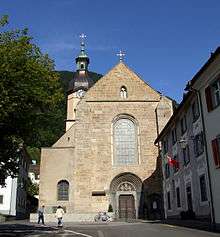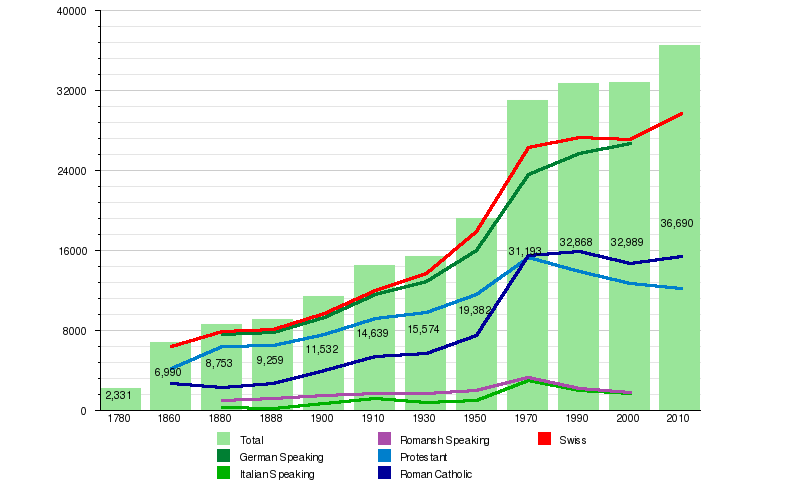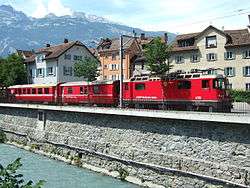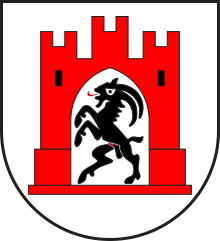Chur
| Chur | ||
|---|---|---|
|
Chur, looking upstream, to the west | ||
| ||
 Chur | ||
|
Location of Chur  | ||
| Coordinates: 46°51′N 9°32′E / 46.850°N 9.533°ECoordinates: 46°51′N 9°32′E / 46.850°N 9.533°E | ||
| Country | Switzerland | |
| Canton | Graubünden | |
| District | Plessur | |
| Government | ||
| • Executive |
Stadtrat with 3 members | |
| • Mayor |
Stadtpräsident (list) Urs Marti FDP/PRD (as of February 2014) | |
| • Parliament |
Gemeinderat with 21 members | |
| Area[1] | ||
| • Total | 28.09 km2 (10.85 sq mi) | |
| Elevation (Postplatz) | 593 m (1,946 ft) | |
| Highest elevation (Fürhörnli) | 1,885 m (6,184 ft) | |
| Lowest elevation (Bettlerküche) | 554 m (1,818 ft) | |
| Population (Dec 2015[2]) | ||
| • Total | 34,652 | |
| • Density | 1,200/km2 (3,200/sq mi) | |
| Demonym(s) | German: Churer(in) | |
| Postal code | 7000-7007 | |
| SFOS number | 3901 | |
| Localities | Altstadt, Sand, Kasernenquartier, Industriegebiet, Loestrasse-Lürlibad, Masans, Rheinquartier | |
| Surrounded by | Churwalden, Domat/Ems, Felsberg, Haldenstein, Maladers, Malix, Trimmis | |
| Twin towns | Bad Homburg (Germany), Cabourg (France), Mayrhofen (Austria), Mondorf-les-Bains (Luxembourg), Terracina (Italy) | |
| Website |
www SFSO statistics | |
Chur or Coire (German: [ˈkuːr] or [ˈxuːr]; Romansh: Cuira [ˈkwerɐ] or [ˈkwoi̯rɐ]; Italian: Coira [ˈkɔi̯ɾa]; French: Coire [ˈkwaʁ])[notes 1] is the capital and largest city of the Swiss canton of Grisons and lies in the Grisonian Rhine Valley, where the Rhine turns towards the north, in the northern part of the canton. The city, which is located on the right bank of the Rhine, is reputedly the oldest town of Switzerland.
The official language of Chur is (the Swiss variety of Standard) German, but the main spoken language is the local variant of the Alemannic Swiss German dialect.
History

.jpg)
Archaeological evidence of settlement at the site, in the Eastern Alps, goes back as far as the Pfyn culture[3] (3900-3500 BC),[4] making Chur one of the oldest settlements in Switzerland. Remains and objects from the Bronze and Iron Ages have been found also in the eastern sector of the current city's centre.
The Roman Empire conquered Raetia in 15 BC. Under emperor Diocletian (late 3rd century AD), the existing settlement of Curia Raetorum was made the capital of the newly established province of Raetia prima.[5] In the 4th century Chur became the seat of the first Christian bishopric north of the Alps. Despite a legend assigning its foundation to an alleged Briton king, St. Lucius, the first known bishop is one Asinio[6] in 451 AD. After the invasion of the Ostrogoths, it was rechristened Theodoricopolis; in the 6th century it was conquered by the Franks.[7] The city suffered several invasions, by the Magyars in 925-926, when the cathedral was destroyed, and by the Saracens (940 and 954), but afterwards it flourished thanks to its location, where the roads from several major Alpine transit routes come together and continue down the Rhine. The routes had been already used under the Romans but acquired greater importance under the Ottonian dynasty of the Holy Roman Empire. Emperor Otto I appointed his vassal Hartpert as bishop of Chur in 958, giving the bishopric numerous privileges. In 1170 the bishop became a prince-bishop and kept total control over the road between Chur and Chiavenna.
In the 13th century the town had some 1,300 inhabitants, and was surrounded by a line of walls. The Gotteshausbund (League of the House of God) was formed in 1367 in Chur to resist the rising power of the Bishopric of Chur and the House of Habsburg. Chur was the chief town of the League and one of the places the Leagues' assemblies met regularly. A burgmeister (mayor) of Chur is first mentioned in 1413, The bishop's residence was attacked by the inhabitants in 1418 and 1422, when a series of concessions were wrung out of him. As the power of the bishops, now increasingly under the influence of the nearby Habsburg County of Tyrol, decreased, in 1464 the citizens wrote a constitution which was adopted as the rule for the local guilds and political positions.The League allied with the Grey League and the League of the Ten Jurisdictions in 1471 to form the Three Leagues. In 1489 Chur obtained the right to have a tribunal of its own, but never had the title of Free Imperial City. Chur adhered to the Reformation in the 16th century, and the Catholic bishopric had to leave the city in 1524. In the same century the German language started to prevail over Romansh. Despite two fires in 1464 and 1574, the city developed economically until the Thirty Years' War, when it was destroyed and struck by plagues.
After the Napoleonic Wars, the Three Leagues became the canton of Graubünden in 1803. The guild constitution of the city of Chur lasted until 1839, while in 1874 the Burgergemeinde was replaced by an Einwohnergemeinde. When Graubünden became a canton in 1803, Chur was chosen as its capital.
Geography
Chur has an area, as of 2006, of 28 square kilometers (11 sq mi). Of this area, 18.8% is used for agricultural purposes, while 52% is forested. Of the rest of the land, 25.1% is settled (buildings or roads) and the remainder (4.1%) is non-productive (rivers, glaciers or mountains).[8]
Chur is situated at a height of 1,949 ft (594 m) above sea level, on the right bank of the torrent Plessur, just as it issues from the valley Schanfigg, and about a mile above its junction with the Rhine, almost entirely surrounded by the Alps, overshadowed by the Mittenberg (northeast) and Pizoggel (southwest), hills that guard the entrance to the deep-cut valley Schanfigg.
The altitude in the city area varies from 600 meters (2,000 ft) above sea level to 1,800 meters (5,900 ft) above sea level, the Churer Hausberg Brambrüesch (accessible from the Old Town) situated at 2,174 meters (7,133 ft) above sea level.
The water of Chur's spring is exported and sold as Passugger mineral water.
Main sights




The modern part of the city is to the west, while the old portion, with all the historical buildings, is to the east. Here is the cathedral church of St Luzius (who is the patron saint of Coire, and is supposed to be a 2nd-century British king Lucius, though in reality the name probably arose from a confusion between Lucius of Cyrene, miswritten curiensis, with the Roman general Lucius Munatius Plancus, who conquered Raetia).

Built between 1178 and 1282, on the site of an older church, it contains many curious medieval antiquities (especially in the sacristy), as well as a picture by Angelica Kauffman, and the tomb of the great Grisons political leader (d. 1637) Jenatsch. Opposite is the Bishop's Palace, and not far off, is the Episcopal Seminary (built on the ruins of a 6th-century monastic foundation). Not far from these ancient monuments is the new Raetian Museum, which contains an extensive collection of objects relating to Raetia (including the geological collections of the Benedictine monk of Disentis Abbey, Placidus a Spescha (1752–1833), who explored the high snowy regions around the sources of the Rhine). One of the hospitals was founded by the famous Capuchin philanthropist, Theodosius Florentini (1808–1865), who was for a long time the Romanist cure of Coire, and whose remains were in 1906 transferred from the cathedral here to Ingenbohl (near Schwyz), his chief foundation. The Romano-Gothic cathedral, where lie the remains of Jörg Jenatsch, was begun by Bishop Tello (758-73), and has a highly interesting crypt; it contains some remarkable paintings by Dürer and Holbein.
Chur is home to many buildings or other sites that are listed as Swiss heritage sites of national significance. There are two archeological sites in Chur, the old city which is a medieval city and Welschdörfli a prehistoric settlement and Roman Vicus. There are four archives or libraries; the bishop's palace (library and archive), the Cantonal Library, the Cantonal Archive of Graubünden and the city archive of Chur. There are also four museums on the list; the Bündner Kunstmuseum (Art Museum), Bündner Naturmuseum (Natural History Museum), the Dommuseum and the Rätisches Museum in the Haus Buol. Three churches are included in the list; The cathedral of the Assumption, the Catholic Church of St. Luzi and the Reformed church of St. Martin. There are 15 other buildings that are also heritage sites; these include the Alte Kaserne at Zeughaus 3 (the Old Armory), the Confederation Paper Mill, the Main Post Office, the new Town Hall, headquarters of the Rhätischen Bahn and several old patrician houses.[9]
The town is home to the Giger Bar designed by the Swiss artist H. R. Giger, the Old Town, the art gallery, and the natural history museum.
Demographics
Chur has a population (as of 31 December 2015) of 34,652.[2] As of 2008, 17.8% of the population was made up of foreign nationals.[10] Over the last 10 years the population has grown at a rate of 7.6%. Most of the population (as of 2000) speaks German (81.0%), with Romansh being second most common (5.4%) and Italian being third (5.1%).[8]
As of 2000, the gender distribution of the population was 47.9% male and 52.1% female.[11] The age distribution, as of 2000, in Chur is; 3,087 children or 9.4% of the population are between 0 and 9 years old. 1,602 teenagers or 4.9% are 10 to 14, and 2,194 teenagers or 6.7% are 15 to 19. Of the adult population, 4,770 people or 14.5% of the population are between 20 and 29 years old. 5,517 people or 16.7% are 30 to 39, 4,616 people or 14.0% are 40 to 49, and 4,254 people or 12.9% are 50 to 59. The senior population distribution is 3,090 people or 9.4% of the population are between 60 and 69 years old, 2,314 people or 7.0% are 70 to 79, there are 1,307 people or 4.0% who are 80 to 89, there are 233 people or 0.7% who are 90 to 99, and 5 people or 0.0% who are 100 or more.[10]
In the 2007 federal election the most popular party was the SP which received 34% of the vote. The next three most popular parties were the SVP (31.8%), the CVP (16.4%) and the FDP (16.3%).[8]
In Chur about 70.3% of the population (between age 25-64) have completed either non-mandatory upper secondary education or additional higher education (either University or a Fachhochschule).[8]
Chur has an unemployment rate of 1.8%. As of 2005, there were 152 people employed in the primary economic sector and about 33 businesses involved in this sector. 3,838 people are employed in the secondary sector and there are 305 businesses in this sector. 21,087 people are employed in the tertiary sector, with 1,957 businesses in this sector.[8]
From the 2000 census, 14,713 or 44.6% are Roman Catholic, while 12,199 or 37.0% belonged to the Swiss Reformed Church. Of the rest of the population, there are 15 individuals (or about 0.05% of the population) who belong to the Christian Catholic Church of Switzerland, there are 589 individuals (or about 1.79% of the population) who belong to the Orthodox Church, and there are 532 individuals (or about 1.61% of the population) who belong to another Christian church. There are 13 individuals (or about 0.04% of the population) who are Jewish, and 917 (or about 2.78% of the population) who are Muslim. There are 424 individuals (or about 1.29% of the population) who belong to another church (not listed on the census), 1,998 (or about 6.06% of the population) belong to no church, are agnostic or atheist, and 1,589 individuals (or about 4.82% of the population) did not answer the question.[10]
Historic population
The historical population is given in the following chart:[12]

| Historic population data [12] | |||||||||||
|---|---|---|---|---|---|---|---|---|---|---|---|
| Year | Population | Swiss | % German speaking | % Italian speaking | % Romansh speaking | % Protestant | % Roman Catholic | ||||
| 13th century | 1,000-1,500 | ||||||||||
| End of 15th century | ca. 1,500 | ||||||||||
| 1780 | 2,331 | ||||||||||
| 1860 | 6,990 | 6,373 | 60.8% | 39.1% | |||||||
| 1880a | 8,753 | 7,866 | 86.6% | 3.2% | 11.3% | 73.6% | 27.8% | ||||
| 1888 | 9,259 | 8,094 | 84.2% | 2.7% | 12.5% | 70.4% | 29.5% | ||||
| 1900 | 11,532 | 9,687 | 80.5% | 5.9% | 12.7% | 65.6% | 34.4% | ||||
| 1910 | 14,639 | 12,042 | 79.4% | 8.0% | 11.6% | 62.8% | 36.8% | ||||
| 1930 | 15,574 | 13,685 | 83.0% | 5.3% | 10.8% | 62.8% | 36.7% | ||||
| 1950 | 19,382 | 17,852 | 83.2% | 5.2% | 10.2% | 60.4% | 38.5% | ||||
| 1970 | 31,193 | 26,332 | 75.6% | 9.7% | 10.6% | 49.1% | 49.6% | ||||
| 1990 | 32,868 | 27,259 | 78.2% | 6.2% | 6.9% | 42.7% | 48.5% | ||||
| 2000 | 32,989 | 27,061 | 81.0% | 5.1% | 5.4% | 38.5% | 44.6% | ||||
| 2010 | 36,690 | 29,695 | 33.3% | 42.0% | |||||||
- ^a Language adds up to over 100% due to counting all languages, not just first language.
Climate
Chur has an oceanic climate in spite of its inland position. Summers are warm and sometimes hot, normally averaging around 25 °C (77 °F) during the day, whilst winter means are around freezing, with daytime temperatures being about 5 °C (41 °F). Between 1961 and 1990 Chur had an average of 105.7 days of rain per year and on average received 814 mm (32.0 in) of precipitation. The wettest month was August during which time Chur received an average of 103 mm (4.1 in) of precipitation. During this month there was precipitation for an average of 11.6 days. The driest month of the year was March with an average of 47 mm (1.9 in) of precipitation over 8.2 days.[13]
| Climate data for Chur (1981-2010) | |||||||||||||
|---|---|---|---|---|---|---|---|---|---|---|---|---|---|
| Month | Jan | Feb | Mar | Apr | May | Jun | Jul | Aug | Sep | Oct | Nov | Dec | Year |
| Average high °C (°F) | 4.8 (40.6) |
6.4 (43.5) |
11.2 (52.2) |
15.1 (59.2) |
20.0 (68) |
22.7 (72.9) |
24.9 (76.8) |
24.1 (75.4) |
20.0 (68) |
16.1 (61) |
9.5 (49.1) |
5.3 (41.5) |
15.0 (59) |
| Daily mean °C (°F) | 0.7 (33.3) |
1.8 (35.2) |
5.9 (42.6) |
9.7 (49.5) |
14.3 (57.7) |
17.1 (62.8) |
19.1 (66.4) |
18.5 (65.3) |
14.8 (58.6) |
10.8 (51.4) |
5.2 (41.4) |
1.7 (35.1) |
10.0 (50) |
| Average low °C (°F) | −2.6 (27.3) |
−2.0 (28.4) |
1.6 (34.9) |
4.6 (40.3) |
8.9 (48) |
11.8 (53.2) |
13.8 (56.8) |
13.7 (56.7) |
10.3 (50.5) |
6.6 (43.9) |
1.7 (35.1) |
−1.4 (29.5) |
5.6 (42.1) |
| Average precipitation mm (inches) | 51 (2.01) |
47 (1.85) |
55 (2.17) |
49 (1.93) |
71 (2.8) |
93 (3.66) |
109 (4.29) |
112 (4.41) |
81 (3.19) |
56 (2.2) |
70 (2.76) |
55 (2.17) |
849 (33.43) |
| Average snowfall cm (inches) | 34 (13.4) |
24.7 (9.72) |
10.3 (4.06) |
1.5 (0.59) |
0.4 (0.16) |
0 (0) |
0 (0) |
0 (0) |
0.1 (0.04) |
0.1 (0.04) |
10 (3.9) |
20.6 (8.11) |
101.7 (40.04) |
| Average precipitation days (≥ 1.0 mm) | 7.3 | 6.6 | 8.1 | 7.5 | 9.9 | 11.2 | 11.0 | 11.2 | 8.4 | 7.0 | 8.5 | 7.9 | 104.6 |
| Average snowy days (≥ 1.0 cm) | 4.8 | 3.9 | 2.5 | 0.4 | 0.1 | 0 | 0 | 0 | 0 | 0 | 1.6 | 4.1 | 17.4 |
| Average relative humidity (%) | 73 | 70 | 65 | 63 | 64 | 67 | 68 | 71 | 73 | 73 | 74 | 75 | 70 |
| Mean monthly sunshine hours | 97 | 112 | 139 | 147 | 169 | 177 | 203 | 185 | 155 | 135 | 93 | 81 | 1,692 |
| Source: MeteoSwiss [14] | |||||||||||||
Transportation


Chur is 120 kilometres (75 miles) by rail from Zürich, and is the meeting-point of the routes from Italy over many alpine passes (Lukmanier Pass, Splugen Pass, and San Bernardino Pass), as well as from the Engadine (Albula Pass, Julier Pass), so that it is the centre of an active trade (particularly in wine from the Valtelline), though it also has a few local factories.
The city's main railway station is where the Swiss Federal Railways system link with that of the Rhaetian Railway (RhB). While the SBB lines serve most of Switzerland, most of Graubünden's internal rail traffic is served by RhB lines. One of the RhB lines (to Arosa) uses on-street running through streets in the centre of Chur and Sand in order to reach the station - see Chur stadtbahn.
There are three other railway stations in Chur:
- Chur Stadt (on the Chur-Arosa line)
- Chur West
- Chur Wiesental
There is also a postbus station situated above the railway station.
Chur is linked by a motorway—the A13.
Coat of arms
Blazon: On silver a red city gate with three merlons, in the gate an upright standing black capricorn.
Twin towns – Sister cities
 Bad Homburg vor der Höhe, Germany
Bad Homburg vor der Höhe, Germany Bad Mondorf, Luxembourg
Bad Mondorf, Luxembourg Cabourg, France
Cabourg, France Mayrhofen, Austria
Mayrhofen, Austria Terracina, Italy
Terracina, Italy
Sport
Ice hockey team, EHC Chur, plays in the Swiss 1. Liga, the third tier of the Swiss ice hockey league system. They play their home games in the 6,500-seat Hallenstadion.
List of notable people




- George Blaurock (c. 1492–1529), Grisonian Catholic pater and leading personality of the Radical Reformation
- Jakob Buchli (1876–1945), born in Chur, engineer in the field of locomotive design
- Binia Feltscher-Beeli (born 1978), born in Chur, Olympic medalist (curling)
- Harry Clarke (1889–1931), buried in Chur, illustrator and stained glass artist
- H. R. Giger (1940–2014), born in Chur, visual artist, painter and Oscar winner
- Kurt Huber (1893–1943), born in Chur, a professor at the Ludwig Maximilian University of Munich, folksong researcher, member of the White Rose, which carried out resistance against Nazi Germany
- Mario Illien (born 1946), born in Chur, engine builder
- Jörg Jenatsch (1596–1639), died in Chur, Grisonian politician during Thirty Years' War
- Angelica Kauffman (1741–1801), born in Chur, Austrian Neoclassical painter who had a successful career in London and Rome
- Adolfo Kind (1848–1907), born in Chur, a chemical engineer and one of the fathers of skiing in Italy
- Johannes Fabricius Montanus (1527–1577), died in Chur, German theologian and poet
- Rudolf Olgiati (1910–1995), born in Chur, important local architect
- Valerio Olgiati (born 1958), born in Chur, renowned architect of Grisonian buildings
- Robert Platow (1900–1982), died in Chur, German journalist, founder and publisher of the Platow Brief, the first and oldest German economics background service
- Giorgio Rocca (born 1975), born in Chur, Italian alpine skier
- Philip Schaff (1819–1893), born in Chur, Protestant theologian and church historian
- Nino Schurter (born 1986), lives in Chur, mountain biker and Olympic gold medalist
- Meinrad Schütter (1910–2006), born in Chur, Swiss composer
- Jeremiah Theus (1716–1746), born in Chur, Swiss-American painter
- Renato Tosio (born 1964), former ice hockey goaltender of EHC Chur
- Johann Baptista von Tscharner (1815–1879), born and died in Chur, lawyer and politician in Chur
- Andreas Walser, 1908–1930, born in Chur, painter
- Peter Zumthor (born 1943), nationwide renowned, contemptory architect, works in Chur
Notes
References
- ↑ Arealstatistik Standard - Gemeindedaten nach 4 Hauptbereichen
- 1 2 Swiss Federal Statistical Office - STAT-TAB, online database – Ständige und nichtständige Wohnbevölkerung nach institutionellen Gliederungen, Geburtsort und Staatsangehörigkeit (German) accessed 30 August 2016
- ↑ Pre-Roman History in German, French and Italian in the online Historical Dictionary of Switzerland.
- ↑ Schibler, J. 2006. The economy and environment of the 4th and 3rd millennia BC in the northern Alpine foreland based on studies of animal bones. Environmental Archaeology 11(1): 49-65
- ↑ Raetia, Page at Switzerland's Historical Dictionary (Italian)
- ↑ Religious life in the Alps, Switzerland Historial Dictionary (Italian)
- ↑ Franks, page at Switzerland Historical Dictionary
- 1 2 3 4 5 Swiss Federal Statistical Office Archived 5 January 2016 at the Wayback Machine. accessed 27-Oct-2009
- ↑ Swiss inventory of cultural property of national and regional significance Archived 1 May 2009 at the Wayback Machine. 21.11.2008 version, (German) accessed 27-Oct-2009
- 1 2 3 Graubunden Population Statistics Archived 27 August 2009 at the Wayback Machine. (German) accessed 21 September 2009
- ↑ Graubunden in Numbers Archived 24 September 2009 at the Wayback Machine. (German) accessed 21 September 2009
- 1 2 Chur in German, French and Italian in the online Historical Dictionary of Switzerland.
- ↑ "Temperature and Precipitation Average Values-Table, 1961-1990" (in German, French, and Italian). Federal Office of Meteorology and Climatology - MeteoSwiss. Archived from the original on 27 June 2009. Retrieved 8 May 2009., the weather station elevation is 556 meters above sea level.
- ↑ "Climate Norm Value Tables". Climate diagrams and normals from Swiss measuring stations. Federal Office of Meteorology and Climatology (MeteoSwiss). Archived from the original on 14 May 2013. Retrieved 23 January 2013.
- ↑ "Partnerstädte" (official web site) (in German). Stadt Chur. Retrieved 2015-01-16.
Sources
- Chur (municipality) in Romansh, German, French and Italian in the online Historical Dictionary of Switzerland.
 This article incorporates text from a publication now in the public domain: Chisholm, Hugh, ed. (1911). "Coire". Encyclopædia Britannica. 6 (11th ed.). Cambridge University Press. p. 654.
This article incorporates text from a publication now in the public domain: Chisholm, Hugh, ed. (1911). "Coire". Encyclopædia Britannica. 6 (11th ed.). Cambridge University Press. p. 654.- A. Eichhorn, Episcopatus Curiensis (St Blasien, 1797)
- W. von Juvalt, Forschungen fiber die Feudalzeit im Curischen Raetien, 2 parts (Zürich, 1871)
- C. Kind, Die Reformation in den Bistumern Chur und Como (Coire, 1858)
- Conradin von Moor, Geschichte von Curraetien (2 vols., Coire, 1870–1874)
- P. C. you Planta, Des alte Raetien (Berlin, 1872); Idem, Die Curraetischen Herrschaften in der Feudalzeit (Bern, 188i); Idem, Verfassungsgeschichte der Stadt Cur im Mittelalter (Coire, 1879); Idem, Geschichte von Graubünden (Bern, 1892).
 This article incorporates text from a publication now in the public domain: Herbermann, Charles, ed. (1913). "Chur". Catholic Encyclopedia. New York: Robert Appleton.
This article incorporates text from a publication now in the public domain: Herbermann, Charles, ed. (1913). "Chur". Catholic Encyclopedia. New York: Robert Appleton.- Principality of Liechtenstein homepage on religion
External links
| Wikimedia Commons has media related to Chur. |
 Chur travel guide from Wikivoyage
Chur travel guide from Wikivoyage- City of Chur - official website (German)
- Chur tourism office (German)
- Chur on Graubünden Holidays, Switzerland; official Graubünden tourism office - English
.jpg)
